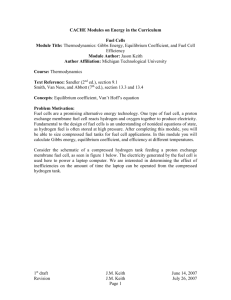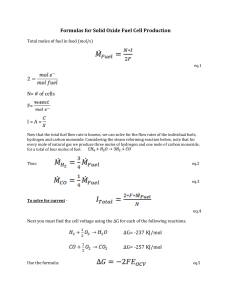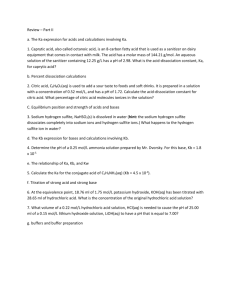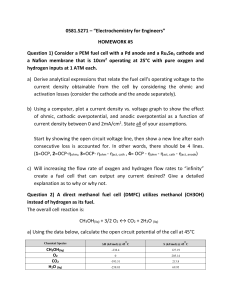Equilibrium Coefficient and Van`t Hoff Equation for Fuel Cell Efficiency
advertisement
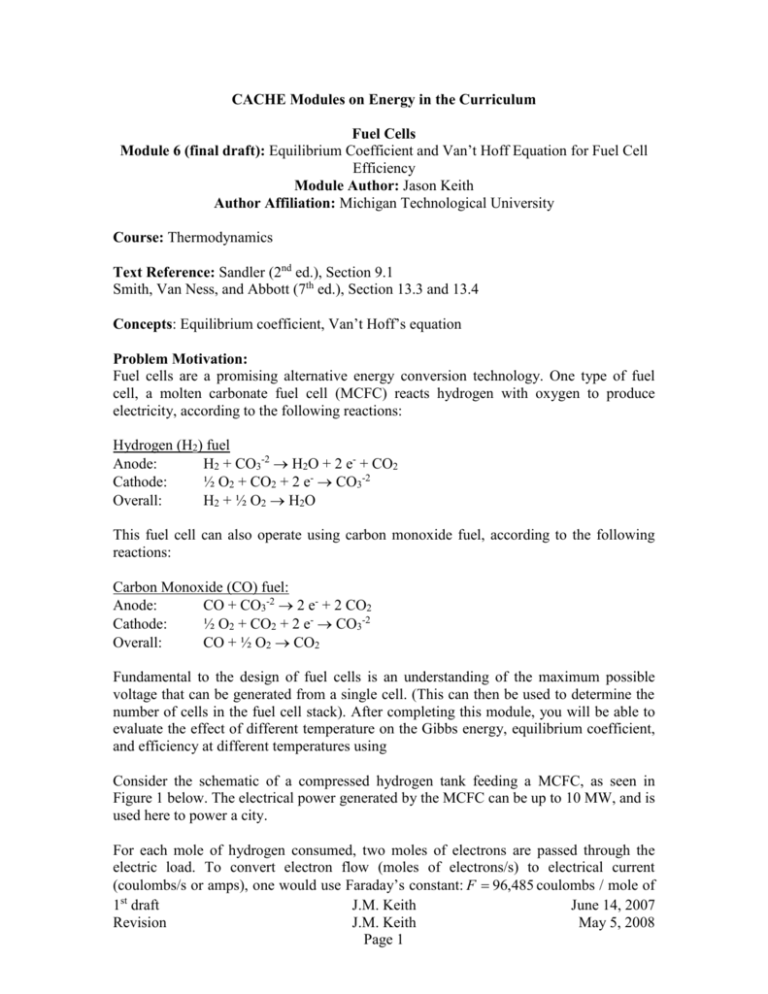
CACHE Modules on Energy in the Curriculum Fuel Cells Module 6 (final draft): Equilibrium Coefficient and Van’t Hoff Equation for Fuel Cell Efficiency Module Author: Jason Keith Author Affiliation: Michigan Technological University Course: Thermodynamics Text Reference: Sandler (2nd ed.), Section 9.1 Smith, Van Ness, and Abbott (7th ed.), Section 13.3 and 13.4 Concepts: Equilibrium coefficient, Van’t Hoff’s equation Problem Motivation: Fuel cells are a promising alternative energy conversion technology. One type of fuel cell, a molten carbonate fuel cell (MCFC) reacts hydrogen with oxygen to produce electricity, according to the following reactions: Hydrogen (H2) fuel Anode: H2 + CO3-2 H2O + 2 e- + CO2 Cathode: ½ O2 + CO2 + 2 e- CO3-2 Overall: H2 + ½ O2 H2O This fuel cell can also operate using carbon monoxide fuel, according to the following reactions: Carbon Monoxide (CO) fuel: Anode: CO + CO3-2 2 e- + 2 CO2 Cathode: ½ O2 + CO2 + 2 e- CO3-2 Overall: CO + ½ O2 CO2 Fundamental to the design of fuel cells is an understanding of the maximum possible voltage that can be generated from a single cell. (This can then be used to determine the number of cells in the fuel cell stack). After completing this module, you will be able to evaluate the effect of different temperature on the Gibbs energy, equilibrium coefficient, and efficiency at different temperatures using Consider the schematic of a compressed hydrogen tank feeding a MCFC, as seen in Figure 1 below. The electrical power generated by the MCFC can be up to 10 MW, and is used here to power a city. For each mole of hydrogen consumed, two moles of electrons are passed through the electric load. To convert electron flow (moles of electrons/s) to electrical current (coulombs/s or amps), one would use Faraday’s constant: F 96,485 coulombs / mole of 1st draft J.M. Keith June 14, 2007 Revision J.M. Keith May 5, 2008 Page 1 electrons. The primary objective of a fuel cell is to deliver energy to the electric load. To calculate the energy delivery rate (also know as power) one would multiply the current times the cell voltage: Power = Current · Voltage. (Recall the unit conversions: coulomb volt Joule and Joule / s Watt ). A “Green” City e- eH2 H2O H2 feed line CO3-2 O2 O2 H2 Air in O2 O2 Anode Gas Chamber O2 H2 H2O CO3-2 H2O H2 Cathode Gas Chamber O2 O2 CO3-2 O2 H2 H2O Anode Cathode Electrolyte Figure 1. Hydrogen reaction in the MCFC Air out H2 and H2O out H2 tank Fuel Cell Figure 2. Diagram for Fueling a City Problem Information Example Problem Statement: In this example we will analyze the hydrogen reaction in the molten carbonate fuel cell. Determine: a) Gibbs energy G and equilibrium coefficient K at both 25 oC and 650 oC b) The theoretical maximum voltage at standard pressure E0 at 650 oC c) The cell efficiency at 650 oC if the cell voltage is assumed to be 700 mV. (Note that this is a good rule of thumb for the operating voltage for a single cell). d) Compare your results at 650 oC to the published values (see Table 7.1 of the 2nd edition of Larminie and Dicks on page 189) (hydrogen, G = -197 kJ/mol and Eocv = 1.02 V) Additional information: (Gˆ of ) H 2O ( g ) = –228.57 kJ/mol (H of ) H 2O( g ) = -241.83 kJ/mol Example Problem Solution: Part a. Step 1) Calculating the Gibbs energy per mole of reactant (in this case, hydrogen) for the above overall reaction at 25°C (298 K) requires the use of the given data according to: 1st draft Revision J.M. Keith J.M. Keith Page 2 June 14, 2007 May 5, 2008 Gˆ ro products i Gˆ ofi i Gˆ ofi reac tan ts Remembering that the Gibbs energy of any elemental substance (hydrogen and oxygen are elemental substances) is zero, we obtain the Gibbs energy of formation of vapor water. Ĝ ro –228.57 kJ/mol (at 298 K) Step 2) We can then determine the equilibrium coefficient, K, which is defined according to the relationship (This is Equation 13.11 on page 490 of the 7th edition of Smith, Van Ness, and Abbott): ΔG = -RT ln K Rearranging this equation, we have: K = exp(-ΔG/RT) Recalling that the gas constant R is 8.314 J , we substitute for G and T to obtain mol K for the formation of water vapor at 298 K: J 228572 mol K = exp J 298K 8.314 mol K K = 1.16 x1040 at 298 K (such that ln K = 92.256) This large value suggests the reaction goes almost to completion. Step 3) To calculate the Gibbs Energy and K at 650°C (923 K), first the value of K must be calculated at the different temperature. This will be performed using Van’t Hoff’s equation (This is Equation 13.15 on page 492 of the 7th edition of Smith, Van Ness, and Abbott): K H 1 1 ln K R 1 T T1 This equation assumes that H is independent of temperature. This allows us to estimate G without using heat capacity integrals (Note that Module 7 uses heat capacity integrals to do this). 1st draft Revision J.M. Keith J.M. Keith Page 3 June 14, 2007 May 5, 2008 Hˆ ro i Hˆ ofi products i Hˆ ofi reac tan ts Since H for hydrogen and oxygen are zero, we have Ĥ ro = –241830 J/mol. Substitution for T, H, R, and K gives: ln K 92.256 241830 J/mol 1 1 8.314 J/mol K 923 K 298 K Thus, ln K = 26.16 K = 2.3 x 1011 at 923 K Step 4) To calculate the Gibbs Energy, we will use the equation directly. ΔG = –RT ln K = (8.314 J )(923K ) ln( 2.3 1011 ) mol K ΔG = - 200.8 kJ/mol at 923 K Part b. The maximum theoretical voltage that can be obtained by converting all of the chemical energy into electricity at standard pressure is given by: E0 G nF where F = Faraday’s constant = 96485 C/mol e- and n is the number of moles of electrons per mole of fuel. (This is Equation 2.2 on page 30 of the 2nd edition of Larminie and Dicks). Recall the anode reaction is given as: H2 + CO3-2 H2O + 2 e- + CO2 Thus 1 mole of H2 produces 2 moles of electrons (n = 2). Thus, E0 J ) mol 1.04 J 1.04 V (2)96485 C C (200766 Part c. The cell efficiency is given by E c / E 0 , where Ec is the cell voltage. Thus, at 650 oC 1st draft Revision J.M. Keith J.M. Keith Page 4 June 14, 2007 May 5, 2008 0.70 V 0.67 1.04 V We note that the efficiency is a ratio of the actual cell voltage divided by the maximum theoretical voltage. This means that 67% of the total energy available in the fuel is converted into electricity, with the remaining energy converted into heat. Thus, a fuel cell could operate for a theoretical maximum of 1 hour (at 1.04 V with no heat losses) would operate for only 40 minutes due to these irreversibilities. Part d.. Compare your results to those published in Larminie and Dicks at 650°C, for hydrogen (ΔG = –197 kJ/mol and E0 = 1.02 V.) The published results compare well with the calculated values for the hydrogen reaction of –200.8 kJ/mol and 1.04 V. Thus, the assumption of constant H used in calculating the K values does not provide a large amount of error. Summary. In this module we have determined the Gibbs energy and equilibrium coefficient at different temperatures. These results were used to determine the theoretical maximum cell voltage. The cell efficiency was calculated for a specific set of operating conditions. The results compared well with literature values. 1st draft Revision J.M. Keith J.M. Keith Page 5 June 14, 2007 May 5, 2008 Home Problem Statement: Determine, for the carbon monoxide reaction in the molten carbonate fuel cell: a) Gibbs Energy G and equilibrium coefficient K at both 25 oC and 650 oC. b) The theoretical maximum voltage at standard pressure E0 at 650 oC c) The voltage efficiency at 650 oC if the cell voltage is 650 mV. d) Compare your results at 650 oC to the published values (see Table 7.1 of the 2nd edition of in Larminie & Dicks on page 189) (carbon monoxide, G = -201 kJ/mol and Eocv = 1.04 V) The following data is available at 25 oC: (Hˆ of ) CO ( g ) = –110.5 kJ/mol (Gˆ of ) CO ( g ) = –137.2 kJ/mol (H of ) CO 2( g ) = -393.5 kJ/mol (Gˆ o ) = -394.4 kJ/mol f CO 2 ( g ) 1st draft Revision J.M. Keith J.M. Keith Page 6 June 14, 2007 May 5, 2008
